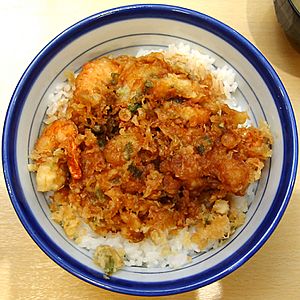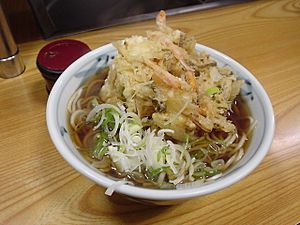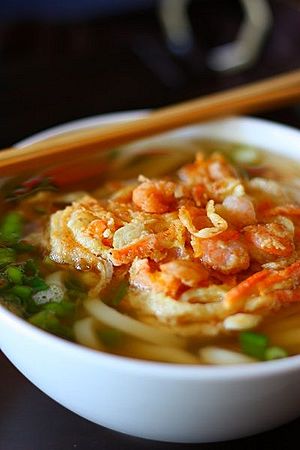Kakiage facts for kids

Kaki age don (kaki age tendon)
|
Kakiage (pronounced kah-kee-ah-geh) is a popular Japanese dish. It is a special kind of tempura. To make it, small pieces of seafood or vegetables are mixed into a light batter. Then, this mix is deep-fried until it's crispy and golden. It's a delicious and common food in Japan!
Contents
What is Kakiage?
Kakiage is a type of tempura. It uses small pieces of seafood, vegetables, or a mix of both. Sometimes, the main ingredients are tiny fish or shellfish. They can also be chopped into small pieces.
You might find shrimp or small scallops in kakiage. Fish can also be used. These are often combined with vegetables like onion or mitsuba. Kakiage can also be made only with vegetables. Common vegetable choices include carrots, burdock, or onions. These are usually cut into thin strips, like matchsticks.
How Kakiage is Made
The mix of ingredients is shaped into flat, round pieces. People sometimes describe them as a type of "pancake" or "fritter".
To cook kakiage, you gently slide the battered mix into hot oil. It can sometimes try to break apart. A spatula might be used to hold its shape until it sets. There are even special tools called kakiage rings. These are cylindrical molds that help keep the shape while cooking. In older ways of cooking, the small pieces that broke off had to be constantly "raked together." This helped them stick to the main piece.
Ways to Enjoy Kakiage
You can eat Kakiage just like other tempura. It's often served with tentsuyu, which is a special tempura dipping sauce. Grated daikon radishes are also a common side. Sometimes, people simply sprinkle seasoned salt on it.
Kakiage is also popular as a topping. A kakiage donburi (or kakiage don) is a bowl of steamed rice with a piece of kakiage on top. A tendon is another rice bowl dish. It includes kakiage along with other tempura pieces. You can also find kakiage on top of hot soba or udon noodles in broth.
Common Ingredients in Japan
In Japan, a type of shrimp called shiba ebi is often used for kakiage. For whole shrimp tempura, shiba ebi and saimaki ebi (young kuruma ebi) are common.
Another popular ingredient is kobashira. These are actually the adductor muscles of certain clams. They are often called small "scallops."
Fresh sakura shrimp are used for kakiage near Suruga Bay in Shizuoka Prefecture. This is where these shrimp are caught. You can also find recipes that use dried sakura shrimp, which are easier to find everywhere.
The Name Kakiage
The name kakiage comes from the Japanese word kakimazeru. This word means "to mix up." It's believed that the dish got its name because you mix up the ingredients before frying them. This explanation has been shared by famous tempura chefs.
Kakiage Through History
Old Japanese writings, like the Morisada mankō (written between 1837 and 1853), mention tempura. They state that soba noodle shops at that time used shiba ebi shrimp for their tempura. Tempura soba, which often uses shiba ebi shrimp kakiage as a topping, was likely invented around the Bunsei era (1818–1830).
Even famous people enjoyed kakiage. The former shogun Tokugawa Yoshinobu (1837–1913) loved it. He would often order a very large kakiage from a restaurant called Tenkin. It was even served on a special Nabeshima plate!
See also
 In Spanish: Kakiage para niños
In Spanish: Kakiage para niños



